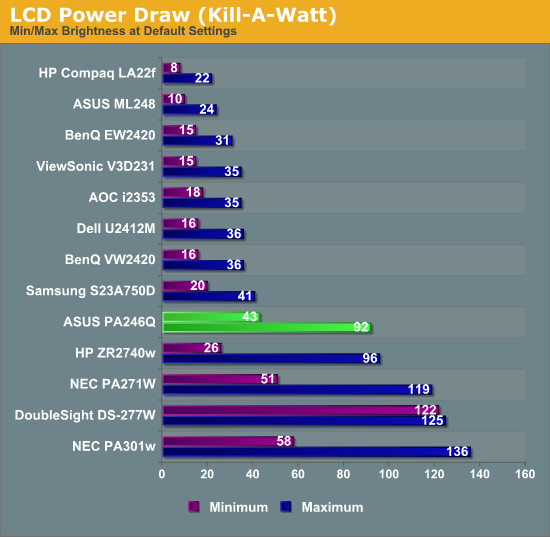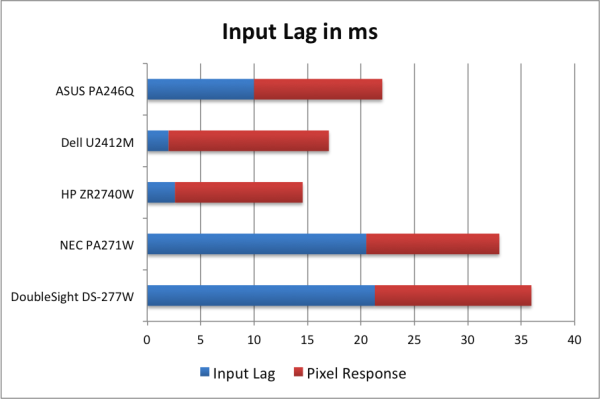ASUS PA246Q 24" ProArt Monitor: No Adjustments Needed?
by Chris Heinonen on July 2, 2012 1:30 PM ESTASUS PA246Q - Input Lag and Power Use
There is no overdrive or game mode on the PA246Q, as it is targeted at graphics and design with gaming as something you might do in your spare time. Despite that, it does reasonably well with just over a frame of lag from our measurements. There is a 10ms input delay for processing the image, and then 24ms of rise and fall time for the pixels themselves, leaving to a total lag of 22ms. Your effective lag is probably right around 16-17ms, so a single frame. It isn’t the fastest gaming monitor out there, but it isn’t bad either.

With its CCFL backlighting system, the PA246Q is not a power efficient display. At minimum brightness it uses more power than the 27” HP ZR2740w and uses just slightly less at maximum brightness despite having maximum light output that is only 65% of that in the HP. Of course it does have a much larger gamut enabled by the CCFL backlighting system, but it does take a lot more power to do so.












52 Comments
View All Comments
Leyawiin - Wednesday, July 4, 2012 - link
Just submitted my order - time for a quality monitor for the first time in my life!cheinonen - Thursday, July 5, 2012 - link
As I mentioned above, they're very different monitors. The PA246Q is a 10-bit panel with a full AdobeRGB color gamut from CCFL backlighting, and the PA248Q is an 8-bit panel with LED backlighting and only the sRGB gamut. It's a more mainstream panel than the PA246Q so for non-print and photo editing users, it might be a better choice, but they aren't practically the same other than size, resolution, and vendor.appliance5000 - Saturday, July 7, 2012 - link
The reviewed monitor is an 8 bit panel interpolated to simulate a 10 bit panel - a little dubious.Oxford Guy - Thursday, July 5, 2012 - link
Is this actually a 10-bit panel?Also, since sRGB mode on some wide gamut monitors works (U2410) and is completely broken on others, whenever you review a wide gamut monitor you should separate its performance in terms of sRGB content and AdobeRGB content. The way you lump them together with a "color quality" chart makes little sense. For those dealing with sRGB content, having a monitor exceed the sRGB space can actually lead to poor quality if the monitor doesn't have an effective sRGB emulation mode.
I would take a look at how prad.de and tftcentral separate sRGB and AdobeRGB modes in their reviews.
cheinonen - Friday, July 6, 2012 - link
I will take a look at that. I've only had a couple come through with AdobeRGB support so far, so I haven't setup a separate test section for it, but I can do that in the future.appliance5000 - Saturday, July 7, 2012 - link
I hear you on the srgb - I have an nec p221w (which is an excellent spectraview compatible monitor for about $400.00. With hardware cal the delta e is well under 1 for adobe rgb at a brightness of 140 cd/m2. I highly recommend it)But, being a wide spectrum (97% adobe rgb) srgb seems tough to calibrate for print. My question is : Isn't s-rgb used mainly to proof for web use, particularly for non color managed environments, in which case a delta e of 3 - 5 is fine? The point being that most people pull a monitor out of the box and turn it on for 5 years - there's no way to know what they're looking at.
aranyagag - Tuesday, December 11, 2012 - link
it clears eizo monitor test and other monitor tests which are supposed to weed out 8 bit monitors. Also I have an sRGB camera, which shows proper colours when the monitor is placed in rgb mode-- laparoscope.Dug - Wednesday, July 11, 2012 - link
I had always thought AdobeRGB was just a higher gamut allowing you to see for instance a raw file shot in AdobeRGB at its full potential. The problem is the assumption that this is better.I've found that most print shops don't have the correct profiles, don't use the embedded profile, etc.
I've gone down the expensive road of getting the correct monitor, printer, and color profiling both to print myself.
In all honesty its a pain in the ass with very little gain.
If everything isn't done just right then you end up with dull colors.
If everything is done right, there is a difference, but I wouldn't necessarily call it better. It may be more accurate, because you've been told it is, but it is subtle.
If you have to email, show on web, print to a printer without correct profile, etc you've wasted all your time if using AdobeRGB.
I kind of relate it to calibrated televisions. If anyone saw a true calibrated television, they probably wouldn't like it. It's very dull. Everyone likes a little extra contrast and run a little hot.
Sense the entire world runs on sRGB, I say stick with it. There's less chance for error and it will look good on anyone's monitor and printer.
CrimsonFury - Thursday, July 12, 2012 - link
Still using my 8 year old Lacie 22" CRT until something better comes along. 4:3 2048x1536 @85Hz. Still waiting for an LCD with that sort of pixel density around 24" in size.I dislike 27" and above screens, I find them too large for a comfortable viewing position. Also on the high res 27" - 30" panels pixels per inch are still lower than my old 22" CRT
AnnonymousCoward - Saturday, July 14, 2012 - link
Looks like a great attempt at a quality monitor. But when are we gonna get past the 60Hz barrier??? At least 80Hz framerate would be so much better.